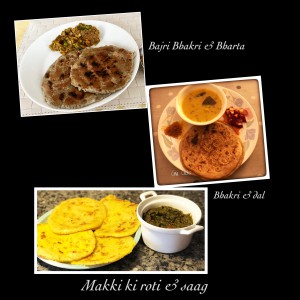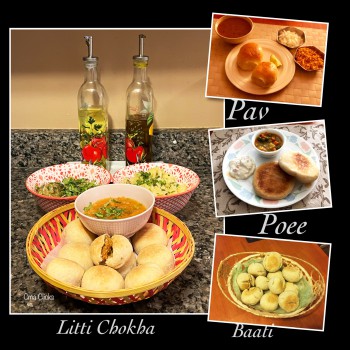As the snow falls and storm warnings are issued on & off, it’s these cold wintry days when one longs for some nice warm, rustic, comforting meals, piping hot lunches, or simmering soups for dinners. That’s when one thinks of some nice warm bread like the Indian flatbread straight from the pan to plate which pairs very well with a bowl of vegetables or even dal (lentils or beans)
‘Roti, chapati, poli’ – that’s the everyday Indian flatbread made fresh in the Indian households. For every day we have the poli, chapati, or phulkas, made with normal wheat flour dough to which a little bit of salt and oil goes in. As I mix the dough with my hands, it reminds me of my mother who would say that the dough should be oiled, mixed well, and covered, rest it for a couple of minutes and let everything seep in. Those days we didn’t discuss gluten formation but then when it was rolled out -what wonderful soft polis we had.
The first time I wrote about breads: Indian Bread Platter -chapati, parathas, naan & kulchas. http://www.megamedia.fi/media/mega_2018_netti.pdf
Unknowingly we end up saying we’ll have chapati or parathas and to our friends who haven’t heard the words, I can imagine it must be tough to understand – and in many ways that’s what happened to me with the availability of breads here –made with different flours, with potatoes or beets, rested differently, different starting agents used, or even some mixture of millets.
Growing up, I was accustomed to one, simple bread that we got from our regular corner shop who sold milk & milk desserts. Never had thought of baking the bread at home. Then for every different vegetable or occasion we could have different flat or puffed-up breads. As I was thinking on the warm breads, I unknowingly had decided this is what I should elaborate in my article.
Typically, we also have pairing of different types of flat bread and what vegetable or the lentils or the beans go with it.
For example, we make ‘Saag’ that goes with ‘Makke di roti’. Saag is the vegetable made with the greens spinach and the mustard greens cooked with ginger, garlic, spices and not to forget the tempering of red dried chili along with mustard seeds. Makke di roti is the unleavened flat bread made with maize / corn meal cooked on the skillet and with the dough made with a bit of salt, carom seeds, ghee and hot water.
Then we make flat breads, Bhakri, that’s what we call it in Marathi. A thicker version with sorghum, pearl millet and even rice and ragi (finger millet) flours which is cooked over the skillet and over direct flame or a hot plate. They are not rolled out but rather flattened with the palm. These bhakris go well with eggplant bharta or with stuffed eggplant veggie or even the pithala- which again differs from household to household, made with chickpea flour. Also, on the sides, chutney is quite common. It usually would be a garlic chutney made with grinding of garlic pods, chili powder, salt and some desiccated coconut. Some add some roasted peanuts too. Then I love how we incorporate the little things to our flat breads like the roasted sesame seeds onto the bajri (pearl millet) Bhakri during the winter times and eaten with the mixed vegetable that are the fresh produce of the season. Now Bhakri in Gujarat would mean a thicker variation of a poli and made with wheat flour, with ghee (clarified butter) added to the dough to make Bhakris more soft and flakier. Eaten with dal or veggie with gravy, this makes a wholesome meal.
Surprisingly seeing Parotta and Roti Canai at Malaysia served with dhal (lentil curry) a very popular Malaysian/Singaporean breakfast, it was so close to our parathas or flaky chapatis that we ate. There again I must say it reminded us of home and we enjoyed these treats.
Then there is baked variety of breads too like ‘Litti’ popular in the state of Bihar or ‘Baati’ popular in Rajasthan and the ‘Poee’ from Goa too. Litti is stuffed wholewheat balls eaten with ‘Choka’ that is roasted eggplant or potatoes relish to which garlic, chili, salt and mustard oil is added. While Baati is with whole wheat flour balls is eaten with dal or mixed lentils and the Goan Poee is a leavened whole wheat bun made with wheat flour, all-purpose flour and wheat bran hence making it delicious. It is versatile and can be eaten with any Indian gravies.
Good bread is the most fundamentally satisfying of all foods; good bread with fresh butter, the greatest of feasts! Couldn’t agree more with the American chef and cookbook author, James Beard
Indeed, the bread is the most robust base for any meal.
Engineer by education, passionate photographer &
food enthusiast from India, presently based at Burling- ton,
Canada is happy to contribute this column
which combines her love of food & photography.
Seema Ganoo




